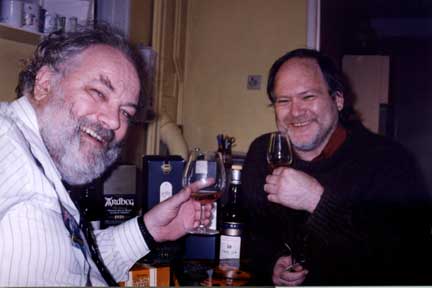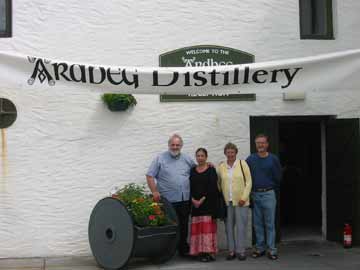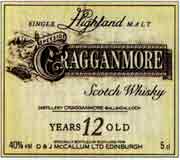|
By whisky, I mean malt whisky, the water of life, made in Scotland from barley, allowed to grow for a few days on the floor of a malting room to turn starch in the barley into sugar, which is dissolved in hot water and allowed to cool. Yeast naturally ferments the sugary liquid into a high alcohol beer, which is distilled twice to produce malt whisky. It is then kept in wooden casks and the flavour of the whisky derives from the peat in the original water and the flavour of the wood. Do not confuse malt whisky with grain whisky, which is made by not allowing the barley (or other forms of corn used) to turn into sugar, hence requiring enzymes, not yeast, to force the starch into alcohol. Most blended whiskies are a mixture of malt and grain. Many folk find them to their taste. I wish I did, because they can be so much cheaper than single malt whiskies. I rarely drink blends containing grain whisky and every taste prevents me from drinking more. I feel grain whisky gives me a bad head and a bad experience, but malt whisky is the perfect tipple for me and for many of my best pals.

Learning the pleasures of real whisky with my mate Gary Davis (the whisky is an Ardbeg 1975)
alexander mcqueen 57795 fashionable shoes for sale in usa pursuit of pattern stack on the present day model.brand new mini cup vape uses modern materials.
Malt whisky, for me, is like a family of children. Don’t ask me which of my children I prefer, because all of them have their own special qualities. I like the malt I am drinking. It is different from all others and, at the moment, it is my favourite. I have never drunk a bad malt whisky (other than the crap the Scots sell to the Italians before it has had at least 10 years to mature.) That said, different malts taste very different and may be preferred in different contexts. So there are a few I return to more often than others.
|
Rich Malts from the Isles and a gem from the north My own particular weakness is for Ardbeg. It is a subtly-flavoured peaty brew, distilled on the Isle of Islay, along the same road as Laphroaig and Lagavulin. It was treated badly by Allied Distillers, who owned it from 1976 to 1997, along with Laphroaig. The two malts even shared some of the same workers. But Allied made money out of their blends and did not need two heavy Islay malts to flavour their brands, so the subtler and more complex Arbeg was mothballed (closed) in 1984. It was started up again in 1989, and now, in the new millenium, 10-year old Ardbeg is available once more, at a rich 46%, with its flavour untarnished by chill-filtering (which would improve its looks but not its taste). The distillery has been in the hands of Glenmorangie since 1997 and this company focuses only on single malt whisky. The old style peating is being emulated, the whisky is given longer in its brewing and distilling to allow the flavours arising to return to their former glory. The future for the lovers of Ardbeg looks bright! |
I don’t drink Ardbeg in the morning, it is too glorious and heavy in taste for that. It deserves savouring later in the evening as do many of the other rich island malts.
 |
A visit to Ardbeg with Lillie Crowley, Sue and Phil Crowley, Friday, July 6th, 2001.
For more pictures, click here. |
 |
A whisky for all times of the day is Cragganmore from the north of Scotland. It is so complex that tasting it at different times in different contexts gives it a variety of subtle flavours. It is fresh in the morning and flavoursome at night. The “experts” will lovingly tell you how to savour whisky by swirling it around the glass to get more air into it to release the taste. Another trick is to add a tiny amount of water (I use a teaspoon to flash two or three tiny drops into the whisky to release the flavour). These are both helpful advice, but my greatest enjoyment comes from the second taste. I prepare my mouth with a tiny flavouring, enjoying the subtle taste and smell, without swilling it round like wine, for that kills the taste buds. With the tongue and inner mouth coated with a delicious quality that is appreciated by the sense organs in the nose, the mouth is ready for that incredible full flavour that is only given to malt whisky. |
Cragganmore is sweet and intriguing, full and rich—a real treat at any time, provided you don’t spoil it by drinking it too often and getting over-accustomed to its subtleties. There are plenty of other members of the malt family with very different qualities to savour at other times over the years.
Many of my regular malt tipples are distilled mainly, but not exclusively, in the Islands. Talisker, from the Isle of Skye explodes in the mouth. You might expect that. It has a high alcohol content at 45.8%, and it is bottled at 10 years when it is still relatively young and lively. Laphroaig, on the other hand, at a regular 40% has a heavy medicinal flavour. This comes from grinding down the malt to small particles to yield more phenol, using strongly-flavoured mossy peat, and keeping the whisky in American oak casks that have previously held bourbon. Laphroaig is mainly released as a rich, medicinal 10 year-old; there is a more refined, 15 year-year old sister who deserves close attention. Lagavulin, distilled a few hundred yards down the same road on the south side of Islay, takes 16 years, drawing its fabulous thick dark flavour from the local peat and its sojourn in sherry barrels. Then there is Bowmore (with accent on the second syllable bo’MORE), which has a wide range of tastes depending on the wood of the barrels, the peat in the water and the time in the cask. The regular 12-year old is a gem, rich and full before its youth is transformed into the subtler refinement of greater maturity. For this we have to thank the Japanese. Suntory bought the Bowmore Distillery, and behaved rather better than the big Scottish conglomerates. Whyte and Mackay, for instance, owners of a historic scottish lineage, purchased Bruchladdich across the bay in 1995 and promptly mothballed it, removing the livelihood from the locals. Suntory, on the other hand, not only encouraged Bowmore to build on their fine scottish traditions, they even turned production from the cheaper, less flavoursome ten-year bottling to the the richer higher quality 12-year. Thank God for Japanese with taste who care more for whisky than large Scots companies with an eye mainly on profit.
Also thank God for the personal entrepreneurs who purchased and restarted the Bruichladdich Distillery, not only for the lightly peated Bruichladdich itself, but also for a more highly peated whisky to be marketed in ten years as “Port Charlotte”. I tasted a drop straight from the still. Oh that I live ten years and more to savour the real thing!
Incidentally, did you know it only takes a dozen or so workers to keep a distillery going. The seven working distilleries on Islay therefore only employ around a hundred or so people, but they pay 150 million pounds a year in excise duty. And you thought you were hard done by!